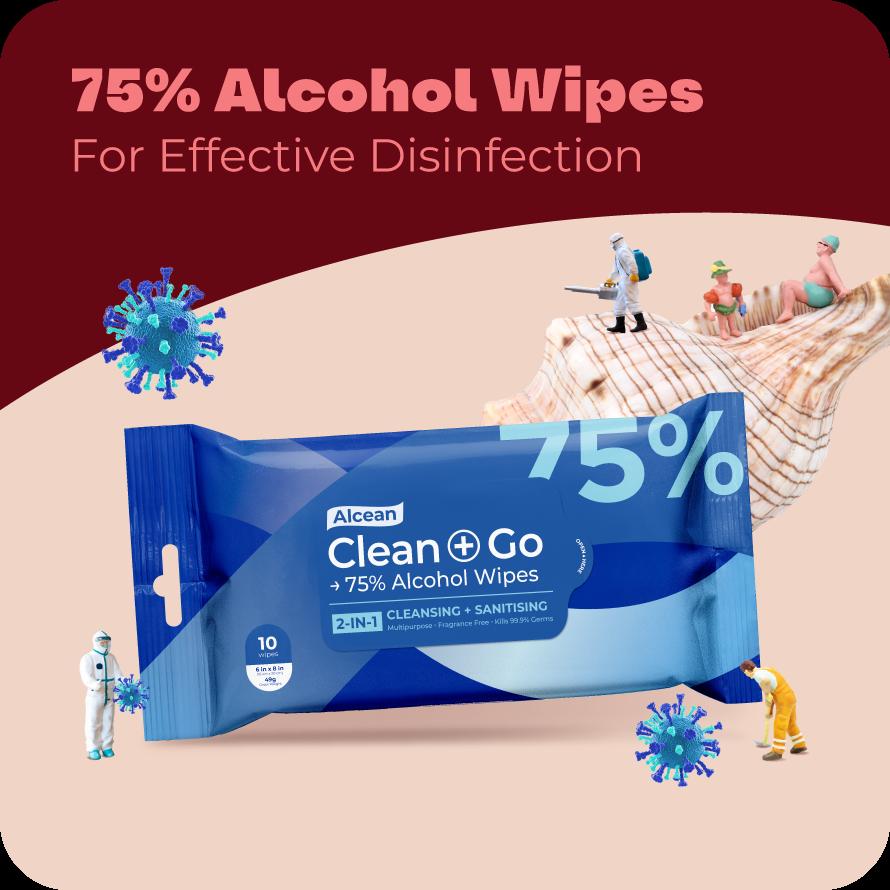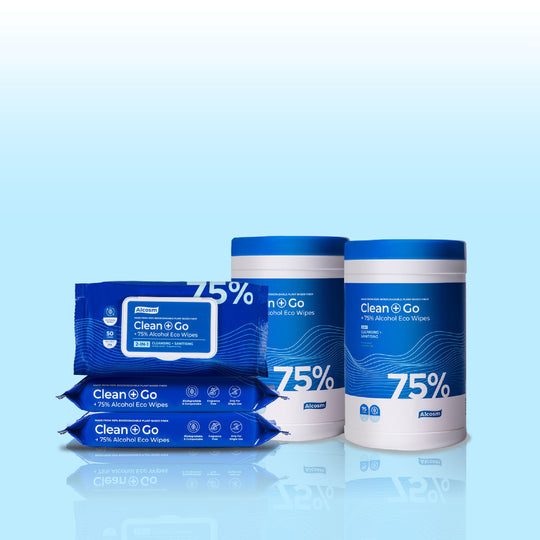Are You Disinfecting, Or Are You Just Cleaning? Find Out How to Kill Viruses

Are You Disinfecting Or Are You Just Cleaning? Find Out How to Kill Viruses
Hygiene Tips | 3 mins read

Many people often believe they are disinfecting while cleaning. In the face of a virus pandemic, cleaning, sanitising, and disinfecting are the three primary tools to prevent spread and contagion. But do you really know which one you are doing?
Discover below the major differences between them and which is the most effective against viruses and germs.
What Is The Difference Between Cleaning, Sanitising, And Disinfecting?
Although you may think they are synonyms, the truth is that these three terms have significant differences in purpose, way of working and products1. Let's talk about them from least to most effective to kill germs.
Cleaning
Cleaning removes visible dirt (such as soil or dust) from objects. It is done by using water with detergents or soap products.
The keyword in this definition is removal since cleaning transfers impurities from one surface to another but does not destroy germs or harm them in any way.
Sanitising
Sanitising takes a step ahead of cleaning by lowering the number of bacteria and certain germs on hard surfaces to reduce the risk of spreading infection. In short, to decrease the bacterial count to a safe level.
A particular thing about sanitising is that it is intended to kill up to at least 99.9% bacteria, but not viruses. Bacteria are much larger and accessible to destroy than viruses. Therefore the latter need an even stronger process for it.
Disinfecting
The last and most important: disinfecting. This process kills all -or almost- all germs from surfaces and objects up to 99.999%, including bacteria and viruses.
In healthcare settings, objects are usually disinfected using powerful liquid chemicals or wet pasteurization. Even at home, it is essential to use medical-grade disinfectants with optimal content to ensure proper disinfection.
Plenty of cleaning products in stores claim to kill 99.9% of bacteria and viruses, but not all are effective. Always check the ingredients and make sure that it has at least 60% alcohol or the right chemical for disinfection.


Table 1: Know the Difference Between Cleaning, Sanitising and Disinfecting.
Disinfectants for Daily Use
Disinfectants are ultimately the most effective antimicrobials to prevent the spread of infection and contagion.
There are so many solutions available with different ingredients that we may fall short of talking about it. However, alcohol stands out among the disinfectants recommended for household and daily use for its safety and easy use.
The most common in healthcare settings are isopropyl and ethyl alcohol due to their potential to denature the proteins of bacteria such as Escherichia coli and multiple viruses, including coronaviruses2.
Both are soluble in water, hence their concentration and processing. Water acts as a catalyst and plays a crucial role in denaturing the germ's cell membrane proteins.
According to the World Health Organization, 75% of alcohol content is a powerful disinfectant against viruses and bacteria suitable for surfaces and skin without being too harsh3.
Other disinfectants include4:
- Benzalkonium chloride
- Chloroxylenol
- Sodium hypochlorite
- Accelerated hydrogen peroxide
When choosing a disinfectant, the most important thing is to closely look at the active ingredient concentration. 75% alcohol acts quickly after surface contact serving as a protective tool against the current SARS-CoV-25.

Alcohol Concentration Does Matter
Alcohol works by denaturing (destroying) the structural elements that make up the germs, causing their destruction and subsequent death. In viruses, there is viral inactivation when in contact with it on the surfaces, both for the enveloped and non-enveloped ones.
The WHO recommends 75% because alcohol concentration below 60% is less effective in killing bacteria and viruses6. However, it doesn't mean that the higher the percentage, the better it is.
99% alcohol is too strong on the skin and evaporates too quickly, which fails to penetrate the cell walls and kill bacteria therefore is not ideal.
Contact Time Required To Kill Viruses
No active ingredient acts immediately, as there must be an optimum time range for it to reach the germ proteins and destroy them. Instead of wiping after disinfection, it is advisable to let the alcohol dry for 10 minutes to ensure its full action.
How Often Should Hands And Surfaces Be Disinfected, According To Experts?
According to experts, disinfecting your hands six to 10 times a day is the keystone in preventing infection. Still, the Centers for Disease Control and Prevention8 recommends it in 10 different situations.
- Before, during, and after cooking.
- Before and after eating.
- Before and after caring for someone who is sick with vomiting or diarrhea.
- Before and after treating a cut or wound.
- After using the toilet.
- After changing diapers or cleaning up a child who has used the toilet.
- After blowing your nose, coughing, or sneezing.
- After touching an animal, animal feed, or animal waste.
- After handling pet food or pet treats.
- After touching garbage.
Also, biosafety measures to prevent the spread of COVID-19 include hands disinfection before and after:
- Touching your eyes, nose, or mouth.
- Touching your mask.
- Entering and leaving a public place.
- Touching an item or surface that other people may frequently touch, such as door handles, tables, gas pumps, shopping carts, or electronic cashier registers/screens.
Why Is Disinfecting Important?
Germs spread quickly if a person nearby is sick, not only through sneezing but also through the hands.
Our hands are the only touch-based communication tool with the outside world. We touch hard surfaces, food, people, clothes, animals, grass, and many other things with them. How do you know if something is germ-contaminated? You really don't.
A person touches their face an average of 23 times per hour 9. Hence germs are picked up from any surface every 23 times and carried close to the mouth and nose, which are the main entry for germs colonisation and thus infection.
Considering the differences between the three processes, disinfecting is the only way to kill viruses and bacteria on any surface, including your hands. There is no point in cleaning or sanitising if the germs still live to pose a risk for you and your loved ones.
Moreover, both viruses and bacteria can live for days or even months on surfaces.
At Alcosm, our purpose is to safeguard you and your loved ones' lives by providing optimal protection against hygiene-related risks.
Feel The Clean With our 75% Alcohol Wipes!
References
- Disinfection & Sterilization Guidelines [Internet]. Cdc.gov. 2019 [cited 2021 Sep 10]. Available from: https://www.cdc.gov/infectioncontrol/guidelines/disinfection/introduction.html
- Boyce JM. Alcohols as surface disinfectants in healthcare settings. Infect Control Hosp Epidemiol. 2018;39(3):323–8.
- CDC. Hand Hygiene Recommendations [Internet]. Cdc.gov. 2020 [cited 2021 Sep 10]. Available from: https://www.cdc.gov/coronavirus/2019-ncov/hcp/hand-hygiene.html
- List of household disinfectants and self-disinfecting surface coating products against COVID-19 virus [Internet]. Gov.sg. [cited 2021 Sep 10]. Available from: https://www.nea.gov.sg/our-services/public-cleanliness/environmental-cleaning-guidelines/guidelines/interim-list-of-household-products-and-active-ingredients-for-disinfection-of-covid-19
- Leslie RA, Zhou SS, Macinga DR. Inactivation of SARS-CoV-2 by commercially available alcohol-based hand sanitizers. Am J Infect Control. 2021;49(3):401–2.
- Use of disinfectants: alcohol and bleach. Genève, Switzerland: World Health Organization; 2014.
- Golin AP, Choi D, Ghahary A. Hand sanitizers: A review of ingredients, mechanisms of action, modes of delivery, and efficacy against coronaviruses. Am J Infect Control. 2020;48(9):1062–7.
- CDC. Cleaning and disinfecting your home [Internet]. Cdc.gov. 2021 [cited 2021 Sep 10]. Available from: https://www.cdc.gov/coronavirus/2019-ncov/prevent-getting-sick/disinfecting-your-home.html?CDC_AA_refVal=https%3A%2F%2Fwww.cdc.gov%2Fcoronavirus%2F2019-ncov%2Fprevent-getting-sick%2Fcleaning-disinfection.html
- Kwok YLA, Gralton J, McLaws M-L. Face touching: a frequent habit that has implications for hand hygiene. Am J Infect Control. 2015;43(2):112–4
- D’Antonio NN, Rihs JD, Stout JE, Yu VL. Revisiting the hand wipe versus gel rub debate: is a higher-ethanol content hand wipe more effective than an ethanol gel rub? Am J Infect Control. 2010;38(9):678–82.



